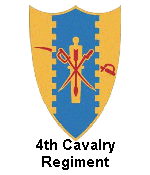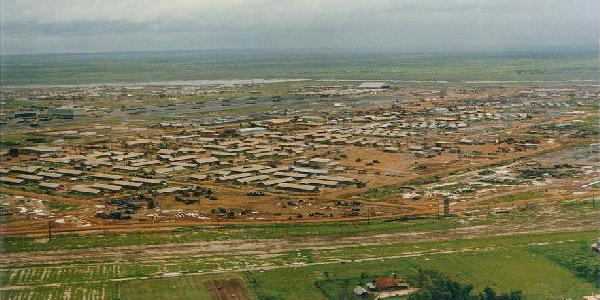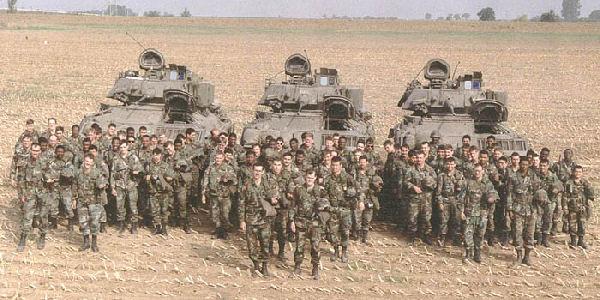

4th Cavalry Regiment
Vietnam War
"Prepared and Loyal"

![]()



![]()
|
|---|
![]() The Geneva Accords stated that the division was to be temporary, and that
national elections in 1956 would reunite the country. But the United States
did not want to see Vietnam turn into a communist state, so the US supported
the creation of the Southeast Asia Treaty Organization, which provided defense
for South Vietnam.
The Geneva Accords stated that the division was to be temporary, and that
national elections in 1956 would reunite the country. But the United States
did not want to see Vietnam turn into a communist state, so the US supported
the creation of the Southeast Asia Treaty Organization, which provided defense
for South Vietnam.
![]() North Vietnam, then called the Democratic Republic of Vietnam, wanted a
communist state, and South Vietnam, then called the Republic of Vietnam,
wanted a non-communist state. In 1956, Ngo Dihn Diem, an anti-communist, won
the presidential election in South Vietnam. But communist opposition in the
south caused Diem numerous problems. And in 1959, southern communists decided
to implement greater violence to try to oust Diem. This led to the formation
of the National Liberation Front (NLF).
North Vietnam, then called the Democratic Republic of Vietnam, wanted a
communist state, and South Vietnam, then called the Republic of Vietnam,
wanted a non-communist state. In 1956, Ngo Dihn Diem, an anti-communist, won
the presidential election in South Vietnam. But communist opposition in the
south caused Diem numerous problems. And in 1959, southern communists decided
to implement greater violence to try to oust Diem. This led to the formation
of the National Liberation Front (NLF).
![]() The NLF was a group of communists and non-communists who opposed diem and
sought his ouster. In 1961, President John F. Kennedy sent a group to South
Vietnam to determine what actions the US needed to take to assist them. When
the group returned, they proffered recommendations in what became known as the
"December 1961 White Paper" that indicated a need for an increased military
presence; but many of the advisors of Kennedy wanted a complete pullout from
the country.
The NLF was a group of communists and non-communists who opposed diem and
sought his ouster. In 1961, President John F. Kennedy sent a group to South
Vietnam to determine what actions the US needed to take to assist them. When
the group returned, they proffered recommendations in what became known as the
"December 1961 White Paper" that indicated a need for an increased military
presence; but many of the advisors of Kennedy wanted a complete pullout from
the country.
![]() In the end, Kennedy compromised and decided to increase the number of military
advisors, but with the objective of not to engage in a massive military
buildup. But in 1963, the government of Diem quickly began to unravel. The
downfall began when Diem's brother accused Buddhist monks of harboring
communists -- his brother then began raiding Buddhist pagodas in an attempt to
find these communists
In the end, Kennedy compromised and decided to increase the number of military
advisors, but with the objective of not to engage in a massive military
buildup. But in 1963, the government of Diem quickly began to unravel. The
downfall began when Diem's brother accused Buddhist monks of harboring
communists -- his brother then began raiding Buddhist pagodas in an attempt to
find these communists
![]() The Buddhist monks immediately began protesting in the streets, and in Saigon
on 05 October, 1963, one monk died by self-immolation. This incident caused
i nternational outrage and Diem was soon overthrown and killed. On 02 August,
1964, North Vietnam attacked an American ship in the Gulf of Tonkin that
resulted in congress enacted the Gulf of Tonkin Resolution, which granted the
president broad war powers.
The Buddhist monks immediately began protesting in the streets, and in Saigon
on 05 October, 1963, one monk died by self-immolation. This incident caused
i nternational outrage and Diem was soon overthrown and killed. On 02 August,
1964, North Vietnam attacked an American ship in the Gulf of Tonkin that
resulted in congress enacted the Gulf of Tonkin Resolution, which granted the
president broad war powers.
![]() Lyndon B. Johnson was the president at the time, and the Gulf of Tonkin
incident and the resultant resolution marked the beginning of the major
military build up of America in the Vietnam War. In 1965, massive bombing
missions by the US in North Vietnam, known as Operation Rolling Thunder,
quickly escalated the conflict.
Lyndon B. Johnson was the president at the time, and the Gulf of Tonkin
incident and the resultant resolution marked the beginning of the major
military build up of America in the Vietnam War. In 1965, massive bombing
missions by the US in North Vietnam, known as Operation Rolling Thunder,
quickly escalated the conflict.
![]() It was initially thought, that the terrain of Vietnam would preclude the use
of armored cavalry in Vietnam. But early successes in mounted operations in
the Vietnamese highlands by "C" Troop, 3rd Squadron, 4th Cavalry, as well as
successes in the area north west of Saigon known as the III Corps Tactical
Zone by the 1st Squadron, 4th Cavalry, 1st Infantry Division and then the
3rd Squadron, 4th Cavalry, 25th Infantry Division, convinced commanders that
given their mobility and firepower, armored cavalry along with tank and
mechanized infantry units supported by air cavalry could be very effective
against Viet Cong and North Vietnamese forces.
It was initially thought, that the terrain of Vietnam would preclude the use
of armored cavalry in Vietnam. But early successes in mounted operations in
the Vietnamese highlands by "C" Troop, 3rd Squadron, 4th Cavalry, as well as
successes in the area north west of Saigon known as the III Corps Tactical
Zone by the 1st Squadron, 4th Cavalry, 1st Infantry Division and then the
3rd Squadron, 4th Cavalry, 25th Infantry Division, convinced commanders that
given their mobility and firepower, armored cavalry along with tank and
mechanized infantry units supported by air cavalry could be very effective
against Viet Cong and North Vietnamese forces.
![]() The 1st Squadron 4th Cavalry was assigned to the 1st Infantry Division as the
division reconnaissance squadron based at Di An. It was the first element of
the 4th Cavalry Regiment to arrive in Vietnam. The squadron's main mission was
to conduct route and convoy security missions primarily along Vietnam's Route
13, the main communications and supply route from the Saigon north through
Binh Doung and Binh Long Provinces. The 1st Squadron successfully accomplished
this mission in face of strong enemy resistance. It also participated in large
scale combined operations such as Cedar Falls and Junction City. Overall the
Quarter Horse as it was known, participated in eleven campaigns of the Vietnam
War from 20 October 1965 to 05 February 1970. The 1st Squadron was awarded a
Presidential Unit Citation for its heroism in Binh Long Province as well as a
Valorous Unit Award for Binh Doung Province. "A" Troop, 1st Squadron received
a Valorous Unit Award for its actions at the battle of Ap Bau Bang.
The 1st Squadron 4th Cavalry was assigned to the 1st Infantry Division as the
division reconnaissance squadron based at Di An. It was the first element of
the 4th Cavalry Regiment to arrive in Vietnam. The squadron's main mission was
to conduct route and convoy security missions primarily along Vietnam's Route
13, the main communications and supply route from the Saigon north through
Binh Doung and Binh Long Provinces. The 1st Squadron successfully accomplished
this mission in face of strong enemy resistance. It also participated in large
scale combined operations such as Cedar Falls and Junction City. Overall the
Quarter Horse as it was known, participated in eleven campaigns of the Vietnam
War from 20 October 1965 to 05 February 1970. The 1st Squadron was awarded a
Presidential Unit Citation for its heroism in Binh Long Province as well as a
Valorous Unit Award for Binh Doung Province. "A" Troop, 1st Squadron received
a Valorous Unit Award for its actions at the battle of Ap Bau Bang.
 |
|---|
| Cu Chi, 25th Infantry Division Base, Northwest of Saigon |
![]() The 3rd Squadron 4th Cavalry served as the reconnaissance squadron for the
25th Infantry Division. The 3rd Squadron completed its deployment to Vietnam
on 24 March 1966 and was based at Cu Chi northwest of Saigon. "C" Troop, 3rd
Squadron initially served with the 3rd Brigade, 25th Infantry Division in the
Central Highlands of Vietnam. There, the troop pioneered the use of armored
cavalry in the thick jungles of that region in fierce fighting against North
Vietnamese units. "C" Troop later saw action against Viet Cong main force
units in Quang Tri Province receiving a Valorous Unit Award. On 1 August 1967,
"C" Troop rejoined the 3rd Squadron at Cu Chi.
The 3rd Squadron 4th Cavalry served as the reconnaissance squadron for the
25th Infantry Division. The 3rd Squadron completed its deployment to Vietnam
on 24 March 1966 and was based at Cu Chi northwest of Saigon. "C" Troop, 3rd
Squadron initially served with the 3rd Brigade, 25th Infantry Division in the
Central Highlands of Vietnam. There, the troop pioneered the use of armored
cavalry in the thick jungles of that region in fierce fighting against North
Vietnamese units. "C" Troop later saw action against Viet Cong main force
units in Quang Tri Province receiving a Valorous Unit Award. On 1 August 1967,
"C" Troop rejoined the 3rd Squadron at Cu Chi.
![]() From 24 March 1966 to 08 December 1970, the 3rd Squadron participated in
twelve campaigns. The squadron's primary mission was to conduct route and
convoy security along Vietnam's Route 1 keeping open the main supply and
communications route from Saigon to Tay Ninh, By 1967 the squadron was
escorting some 8,000 vehicles a month operating both day and night escorts. It
also participated in large scale combined arms operations such as Cedar Falls,
Junction City and the invasion of Cambodia. During the Communist Tet Offensive
of January 1968 the 3rd Squadron was rushed to Tan Son Nhut airbase outside of
Saigon where it successfully repelled a massive Viet Cong attempt to seize
the air base.
From 24 March 1966 to 08 December 1970, the 3rd Squadron participated in
twelve campaigns. The squadron's primary mission was to conduct route and
convoy security along Vietnam's Route 1 keeping open the main supply and
communications route from Saigon to Tay Ninh, By 1967 the squadron was
escorting some 8,000 vehicles a month operating both day and night escorts. It
also participated in large scale combined arms operations such as Cedar Falls,
Junction City and the invasion of Cambodia. During the Communist Tet Offensive
of January 1968 the 3rd Squadron was rushed to Tan Son Nhut airbase outside of
Saigon where it successfully repelled a massive Viet Cong attempt to seize
the air base.
![]() For its gallantry at Tan Son Nhut the 3rd Squadron was awarded a Presidential
Unit Citation. In addition, the squadron received two Valorous Unit Awards for
battles along the Cambodian border and in Binh Doung Province. In addition,
"D" Troop (Air), 3rd Squadron received a Presidential Unit Citation for
gallantry in Tay Ninh Province. "A" Troop, 3rd Squadron received a Valorous
Unit Award for contributing to the defeat of Viet Cong forces in the Cu Chi
District. The 1st Platoon, "A" Troop, 3rd Squadron also received a
Presidential Unit Citation while attached to the 1st Battalion, 5th Infantry
during the battle of Ben Cui.
For its gallantry at Tan Son Nhut the 3rd Squadron was awarded a Presidential
Unit Citation. In addition, the squadron received two Valorous Unit Awards for
battles along the Cambodian border and in Binh Doung Province. In addition,
"D" Troop (Air), 3rd Squadron received a Presidential Unit Citation for
gallantry in Tay Ninh Province. "A" Troop, 3rd Squadron received a Valorous
Unit Award for contributing to the defeat of Viet Cong forces in the Cu Chi
District. The 1st Platoon, "A" Troop, 3rd Squadron also received a
Presidential Unit Citation while attached to the 1st Battalion, 5th Infantry
during the battle of Ben Cui.
![]() On 10 February 1971, "F" Troop, 4th Cavalry was activated in Vietnam and
assigned to the 25th Division as a separate air cavalry troop in support of
the 2nd Brigade, 25th Division. After the 2nd Brigade left Vietnam on 30 April
1971, "F" Troop remained assigned to the 25th while serving with the 11th and
12 Aviation Groups. It was one of the last Army units to leave Vietnam on 26
February 1973.
On 10 February 1971, "F" Troop, 4th Cavalry was activated in Vietnam and
assigned to the 25th Division as a separate air cavalry troop in support of
the 2nd Brigade, 25th Division. After the 2nd Brigade left Vietnam on 30 April
1971, "F" Troop remained assigned to the 25th while serving with the 11th and
12 Aviation Groups. It was one of the last Army units to leave Vietnam on 26
February 1973.
![]() In 1972, two years after its return from Vietnam, the 3rd Squadron, 4th
Cavalry was reorganized from an armored cavalry squadron to an air cavalry
squadron with maneuver elements consisting of one armored cavalry troop
equipped with tanks and armored personnel carriers and two air cavalry troops
equipped with helicopters. In the mid-1980s the Army decided to move to a unit
replacement system whereby soldiers would spend the majority of their army
careers rotating between the elements of a regiment located in the United
States and overseas. In order to set up the proper alignment of like units old
historic long-term assignments of regiments in certain divisions were
terminated.
In 1972, two years after its return from Vietnam, the 3rd Squadron, 4th
Cavalry was reorganized from an armored cavalry squadron to an air cavalry
squadron with maneuver elements consisting of one armored cavalry troop
equipped with tanks and armored personnel carriers and two air cavalry troops
equipped with helicopters. In the mid-1980s the Army decided to move to a unit
replacement system whereby soldiers would spend the majority of their army
careers rotating between the elements of a regiment located in the United
States and overseas. In order to set up the proper alignment of like units old
historic long-term assignments of regiments in certain divisions were
terminated.
 |
|---|
| "B" Troop, 4th Squadron, 4th Cavalry Regiment - After REFORGER 1988. |
![]() As part of this reorganization Department of the Army decided that
all 4th Cavalry elements would be armored cavalry and assigned to heavy
divisions. Thus on 16 March 1987 the 3rd Squadron, 4th Cavalry was inactivated
as the 25th Infantry Division had been designated a light division. The 1st
Squadron, 4th Cavalry, organized as an armored cavalry squadron, remained
assigned to the 1st Infantry Division (Mechanized). The 4th Squadron was
reactivated in 1986 and was assigned to the 3rd Infantry Division (Mechanized)
in Germany. Pressure to return the highly decorated 3rd Squadron to active
duty led the Army to replace the 4th Squadron with the 3rd Squadron on 16 June
1989. One of the missions of both squadrons was the patrolling of the
inner-German border until the collapse of East Germany in 1990.
As part of this reorganization Department of the Army decided that
all 4th Cavalry elements would be armored cavalry and assigned to heavy
divisions. Thus on 16 March 1987 the 3rd Squadron, 4th Cavalry was inactivated
as the 25th Infantry Division had been designated a light division. The 1st
Squadron, 4th Cavalry, organized as an armored cavalry squadron, remained
assigned to the 1st Infantry Division (Mechanized). The 4th Squadron was
reactivated in 1986 and was assigned to the 3rd Infantry Division (Mechanized)
in Germany. Pressure to return the highly decorated 3rd Squadron to active
duty led the Army to replace the 4th Squadron with the 3rd Squadron on 16 June
1989. One of the missions of both squadrons was the patrolling of the
inner-German border until the collapse of East Germany in 1990.
![]() Meanwhile the 2nd Squadron which had been inactivated in Germany in 1972 after
serving both in the 4th Armored Division and then in the 1st Armored Division,
was reactivated with the 24th Infantry Division (Mechanized) at Fort Stewart,
Georgia in January 1987.
Meanwhile the 2nd Squadron which had been inactivated in Germany in 1972 after
serving both in the 4th Armored Division and then in the 1st Armored Division,
was reactivated with the 24th Infantry Division (Mechanized) at Fort Stewart,
Georgia in January 1987.




 Need a gift for an Alumni of the 1st Cavalry Division? |
|---|


![]() eMail Your WebSite Comments.
eMail Your WebSite Comments.
![]()
![]()
![]() Return to "MyOwnPages"©.
Return to "MyOwnPages"©.
![]()
Revised 27 Jan '12 SpellChecked